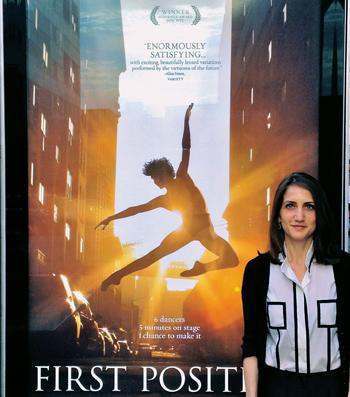Ballet Dreams
By Naomi Shulman

[Film] Two years ago Bess Kargman, an unpaid intern for a Manhattan film production company, was out grabbing lunch when the banners for the Youth America Grand Prix, an international ballet competition, caught her eye. Kargman, who had studied ballet seriously as a child, ducked in for just a quick peek—but when 11-year-old Miko Fogarty took the stage, the girl’s uncommon poise, professionalism and sheer talent had Kargman transfixed.
Her lunch hour long gone, Kargman walked out of the auditorium with an idea for the ballet movie she had always wanted to see: one that focused not just on exhilarating dancing but also on the nitty-gritty of the young dancers’ lives—their workload, social lives, schooling, even diet and sleep regimens.
This documentary, First Position, would eventually star Miko, along with five other passionate young dancers. But first, Kargman had to go back to work, where she floated the concept with her production company. It turned out to be her last pitch, because when the company passed, Kargman decided to quit. “I said, ‘Fine. I’m leaving, and I’m doing it myself.’”
“The hunger those dancers have—I had that,”
says First Position filmmaker Bess Kargman ’04.
Thus began a two-year adventure in first-time filmmaking. Kargman coupled her passion with perseverance, and the same can be said of her subjects. A major commitment is necessary for the serious study of ballet—something Kargman had ultimately chosen to forgo. “You have to be willing to give up a lot,” she says. “But even though I moved on from dance, my appreciation for it never waned.” Her own experience gave her insight as she filmed her subjects over the next year. “That hunger those dancers have—I had that. I lived what they lived when I was young, which may be why I earned their trust.”
Because the dancers and their families opened up to Kargman, audiences gain a level of onscreen intimacy with them, too. Kargman points to Miko’s mother, Satoko Fogarty, who, in another director’s movie, might have been portrayed as a nutty stage mom. Not so here; Kargman made certain of it. “Satoko trusted me to portray her with accuracy. In a previous cut of this film, I’d show it to friends and they’d say, ‘Whoa, she’s psycho.’ Then I knew I hadn’t done a good job, because she’s not psycho. She’s lovely,” Kargman insists. “So I had to go back to the editing room.”
Kargman credits her journalism background for this balanced portrayal of people’s stories. After studying fine art at Amherst, she attended the Columbia University Graduate School of Journalism. “My backbone is journalism—a story is as good as its characters, and access is everything.” But the chutzpah it took to embark on this project, as a first-time director? That she traces back to Amherst. “At Amherst I developed confidence and a sense of autonomy. I created my own class one semester. It was extremely important to have the intellectual freedoms I had,” she says. “I don’t know if it’s in my temperament or personality, or if that sense of intellectual autonomy that I experienced at Amherst was too much in my being to ignore.”
First Position has garnered an impressive amount of praise for any film, let alone a directorial debut. Film festivals in San Francisco, New York, Vancouver, Portland and Toronto have heaped prizes upon it. The Chicago Tribune called it “compelling and emotionally involving”; Time referred to it as “a valentine to the art.” Kargman knows that all this recognition is unusual. “Documentaries,” she says, “especially those created by first-time filmmakers, rarely make it into movie theaters, so the fact that First Position is slated for theatrical release in dozens of countries and has screened in nearly 200 U.S. theaters is surreal.”
But despite this spectacular success, Kargman—like the dancers she profiled—is still young, and her career stretches before her. She recently left New York City for Los Angeles, where she has signed with an agency and is getting ready to direct “something big.” The first position, after all, is only the beginning step.
Shulman has written for The New York Times, Ladies’ Home Journal, Yankee and other publications. She lives in Northampton.